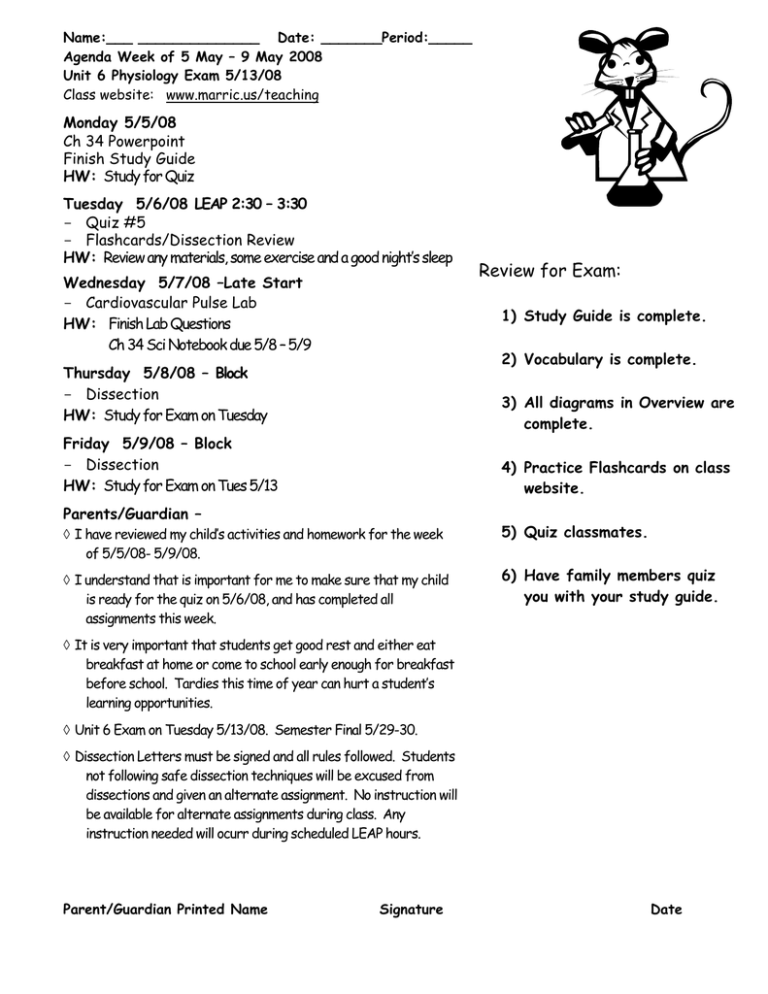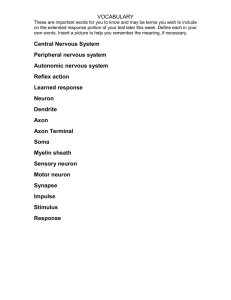Document 17774834
advertisement

Name:___ ______________ Date: _______Period:_____ Agenda Week of 5 May – 9 May 2008 Unit 6 Physiology Exam 5/13/08 Class website: www.marric.us/teaching Monday 5/5/08 Ch 34 Powerpoint Finish Study Guide HW: Study for Quiz Tuesday 5/6/08 LEAP 2:30 – 3:30 - Quiz #5 - Flashcards/Dissection Review HW: Review any materials, some exercise and a good night’s sleep Wednesday 5/7/08 –Late Start - Cardiovascular Pulse Lab HW: Finish Lab Questions Ch 34 Sci Notebook due 5/8 – 5/9 Review for Exam: 1) Study Guide is complete. 2) Vocabulary is complete. Thursday 5/8/08 – Block - Dissection HW: Study for Exam on Tuesday 3) All diagrams in Overview are complete. Friday 5/9/08 – Block - Dissection HW: Study for Exam on Tues 5/13 4) Practice Flashcards on class website. Parents/Guardian – I have reviewed my child’s activities and homework for the week of 5/5/08- 5/9/08. 5) Quiz classmates. I understand that is important for me to make sure that my child is ready for the quiz on 5/6/08, and has completed all assignments this week. 6) Have family members quiz you with your study guide. It is very important that students get good rest and either eat breakfast at home or come to school early enough for breakfast before school. Tardies this time of year can hurt a student’s learning opportunities. Unit 6 Exam on Tuesday 5/13/08. Semester Final 5/29-30. Dissection Letters must be signed and all rules followed. Students not following safe dissection techniques will be excused from dissections and given an alternate assignment. No instruction will be available for alternate assignments during class. Any instruction needed will ocurr during scheduled LEAP hours. Parent/Guardian Printed Name Signature Date Bell Ringers: Week of 5 May – 9 May 2008 Monday – Which of the following is NOT part of the peripheral nervous system? a. spinal cord b. axons c. sensory receptors d. motor neurons Explain the difference between the peripheral and the central nervous systems A neuron consists of a ______. a. cell wall, cell body, and DNA. b. cell body, axons, and impulses. c. d. chloroplast, axons, dendrites. cell body, axon, dendrites. Tuesday – The largest part of your brain is called the ____________. a. medulla oblongata b. cerebrum. c. cerebellum. d. pituitary. The part of your brain that connects to your spinal cord is called the _______________. a. medulla oblongata b. cerebrum. c. cerebellum. d. pituitary. Your _________________ controls your heart rate, breathing, and other involuntary activities. a. medulla oblongata b. cerebrum. c. cerebellum. d. pituitary. The ________________ primarily controls activities such as speaking, reading, writing, and solving problems. a. cerebellum b. medulla c. hypothalamus d. cerebrum Wednesday – The ____ directs the left side of the body. a. medulla c. cerebrum's right hemisphere b. cerebellum d. cerebrum's left hemisphere Explain how the left and right sides of your brain are connected http://faculty.washington.edu/chudler/split.html Thursday/Friday – What is the pathway a nerve impulse will take when traveling between a sensory receptor and a motor neuron? a. dendrite—cell body—axon—synapse—dendrite—cell body–axon b. axon—dendrite—cell body—synapse—axon—dendrite—cell body c. dendrite—cell body—axon—synapse—axon—cell body—dendrite d. axon—cell body—dendrite—synapse—axon—cell body—dendrite Once any sensory receptor is activated, the stimulus from the environment is changed into ___. a. light energy. c. a photoreceptor. b. a chemoreceptor. d. a nerve impulse. Explain how nerve impulses travel through a neuron.. Name:_______________________________ Date:____________________ Period:______ Unit 6 Quiz 5 5/6/08 Vocabulary Matching ____ Cholesterol ____ Digestive system A. A structure composed of modified epithelial cells specialized to produce one or more secretions that are discharged to the outside B. A long carbon chain carboxylic acid; vary in length and in the number and location of double bonds; three linked to a glycerol molecule form fat. _____ Homeostasis C. Rhythmic waves of contraction of smooth muscle that push food along the digestive tract. _____ Fatty Acid D. An organism or a virus that causes disease. _____ Olfactory E. A steroid that forms an essential component of animal cell membranes and acts as a precursor molecule for the synthesis of other important steroids. _____ Insulin F. A protein (or protein-based molecule) that speeds up a chemical reaction in a living organism; acts as catalyst for specific chemical reaction. _____ Virus G. The steady-state physiological condition of the body – maintaining conditions. _____ Polypeptide H. The primary function is to convert food into energy and convert waste into excretable material. _____ Peristalsis I. A submicroscopic, noncellular particle composed of a nucleic acid core and a protein coat (capsid); parasitic; reproduces only within a host cell. _____ Pathogen J. having to do with the sense of smell, involves the detection and perception of chemicals floating in the air ____ Enzyme K. A polymer (chain) of many amino acids linked together by peptide bonds. ____ Gland L. A vertebrate hormone that lowers blood glucose levels by promoting the uptake of glucose by most body cells and the synthesis and storage of glycogen in the liver; forms in the pancreas.




